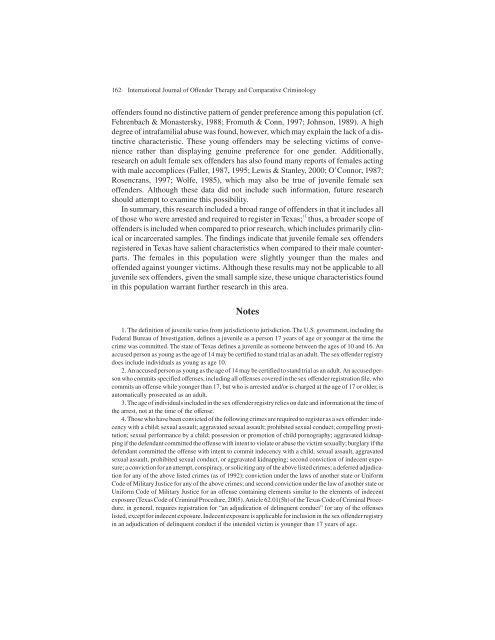Juvenile Female and Male Sex Offenders
Juvenile Female and Male Sex Offenders
Juvenile Female and Male Sex Offenders
You also want an ePaper? Increase the reach of your titles
YUMPU automatically turns print PDFs into web optimized ePapers that Google loves.
162 International Journal of Offender Therapy <strong>and</strong> Comparative Criminologyoffenders found no distinctive pattern of gender preference among this population (cf.Fehrenbach & Monastersky, 1988; Fromuth & Conn, 1997; Johnson, 1989). A highdegree of intrafamilial abuse was found, however, which may explain the lack of a distinctivecharacteristic. These young offenders may be selecting victims of conveniencerather than displaying genuine preference for one gender. Additionally,research on adult female sex offenders has also found many reports of females actingwith male accomplices (Faller, 1987, 1995; Lewis & Stanley, 2000; O’Connor, 1987;Rosencrans, 1997; Wolfe, 1985), which may also be true of juvenile female sexoffenders. Although these data did not include such information, future researchshould attempt to examine this possibility.In summary, this research included a broad range of offenders in that it includes allof those who were arrested <strong>and</strong> required to register in Texas; 11 thus, a broader scope ofoffenders is included when compared to prior research, which includes primarily clinicalor incarcerated samples. The findings indicate that juvenile female sex offendersregistered in Texas have salient characteristics when compared to their male counterparts.The females in this population were slightly younger than the males <strong>and</strong>offended against younger victims. Although these results may not be applicable to alljuvenile sex offenders, given the small sample size, these unique characteristics foundin this population warrant further research in this area.Notes1. The definition of juvenile varies from jurisdiction to jurisdiction. The U.S. government, including theFederal Bureau of Investigation, defines a juvenile as a person 17 years of age or younger at the time thecrime was committed. The state of Texas defines a juvenile as someone between the ages of 10 <strong>and</strong> 16. Anaccused person as young as the age of 14 may be certified to st<strong>and</strong> trial as an adult. The sex offender registrydoes include individuals as young as age 10.2. An accused person as young as the age of 14 may be certified to st<strong>and</strong> trial as an adult. An accused personwho commits specified offenses, including all offenses covered in the sex offender registration file, whocommits an offense while younger than 17, but who is arrested <strong>and</strong>/or is charged at the age of 17 or older, isautomatically prosecuted as an adult.3. The age of individuals included in the sex offender registry relies on date <strong>and</strong> information at the time ofthe arrest, not at the time of the offense.4. Those who have been convicted of the following crimes are required to register as a sex offender: indecencywith a child; sexual assault; aggravated sexual assault; prohibited sexual conduct; compelling prostitution;sexual performance by a child; possession or promotion of child pornography; aggravated kidnappingif the defendant committed the offense with intent to violate or abuse the victim sexually; burglary if thedefendant committed the offense with intent to commit indecency with a child, sexual assault, aggravatedsexual assault, prohibited sexual conduct, or aggravated kidnapping; second conviction of indecent exposure;a conviction for an attempt, conspiracy, or soliciting any of the above listed crimes; a deferred adjudicationfor any of the above listed crimes (as of 1992); conviction under the laws of another state or UniformCode of Military Justice for any of the above crimes; <strong>and</strong> second conviction under the law of another state orUniform Code of Military Justice for an offense containing elements similar to the elements of indecentexposure (Texas Code of Criminal Procedure, 2005). Article 62.01(5h) of the Texas Code of Criminal Procedure,in general, requires registration for “an adjudication of delinquent conduct” for any of the offenseslisted, except for indecent exposure. Indecent exposure is applicable for inclusion in the sex offender registryin an adjudication of delinquent conduct if the intended victim is younger than 17 years of age.


